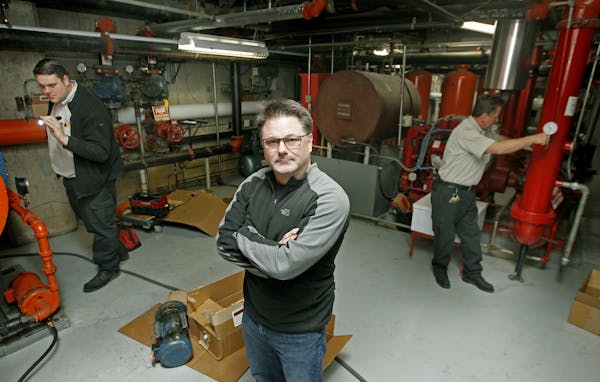Monday's thaw had Minnesotans awash in bliss, driving with car windows half-rolled down, or strolling in the warmth and sunshine.
That is, when they weren't lurching through axle-cracking potholes or wading through puddles the size of small lakes. Potholes and puddles. They happen every year. But this year's pre-spring potholes and puddles are much worse than usual, thanks to the particularly brutal winter, state Department of Transportation spokesman Kent Barnard said Monday.
And with more than 4,000 lane-miles of busy roads in the Twin Cities metro area, crews can't get to them all at once, Barnard said.
Mike Kennedy, director of transportation and repair for the city of Minneapolis, echoed that caution, saying that this winter's conditions combined "the perfect ingredients to create a bad pothole season."
The relentless subzero weather caused frost to creep more deeply
into the soil, trapping more moisture than usual.
The deep cold also led to more pavement cracking and buckling.
And now comes the melt — the season for sometimes daily freeze-thaw cycles.
Monday brought a thaw. Much of Tuesday will bring temperatures below freezing, with a chance of freezing rain or light snow — the ideal recipe for even more potholes and puddles.
Anoka County engineer Doug Fischer said it's all just part of spring in Minnesota. "We're all glad the weather changes," he said. "But along with the changing weather comes the explosion of potholes on our system."
Around the state, on city streets, county roads and state highways, crews are working day and night to fill the holes and drain the puddles. Sometimes, more than once.
Fischer said some Anoka County residents have called wondering when certain potholes will get fixed even after they have already been patched a time or two. It's been so cold that pothole filler doesn't stick well to frozen roads, he said.
The arrival of spring allows road crews to switch from a cold-weather asphalt mix to a more effective hot one. But that's still a temporary fix until crews resurface or restructure the road entirely.
Older roads that haven't had as much repair or upkeep in recent years have been the hardest hit, Barnard said. But, he added, "I wouldn't say there's any [road] that has escaped unscathed."
And keeping up with repairs can be like the arcade game Whac-A-Mole as new potholes pop up or resurface overnight. That'll be the case until warmer, drier weather arrives for good, officials said.
"A really important thing to realize at this time [is] everything we do is a temporary fix," Minneapolis' Kennedy said.
Fischer said his crews' top priorities are patching potholes so large that they could be dangerous, as well as those on high-speed, high-traffic routes.
"We're just trying to hit all the wheel-busters out there," Fischer said, adding that smaller "nuisance" potholes will get fixed later.
In Minneapolis, too, crews are doing as much as they can as quickly as possible, Kennedy said. Every morning during this warming period, they tackle the areas that need the most attention.
"Those priorities can change daily, weekly, hourly," Kennedy said. "With this kind of flooding and the potholes, everything happens everywhere at once."
Puddles like ponds
It has been a giant balancing act between street departments and sewer departments to fix both the potholes and the street flooding, Kennedy said. Many puddles form when huge piles of snow pushed to the sides of roads all winter block storm drains and catch basins, leaving water nowhere to drain, so crews are now clearing snow from the drains.
Minneapolis has about 50,000 catch basins, Kennedy said, which makes it a challenge to keep up.
St. Paul has noticed an increase in the number of potholes this winter, but the amount of street flooding is fairly consistent with similar winters, said city spokeswoman Kari Spreeman. Crews there have been using steamers to melt the snow covering drains in combination with plows to push it aside.
Doug Meyenburg, who heads Coon Rapids' street department, worked Monday on one of four crews that were clearing snow from storm-sewer drains. He said the city is working hard to clear the drains. Sometimes, he said, residents pitch in and help out.
"It really makes our job so much easier when they go out and get the water running a little bit," Meyenburg said.
'Just be patient'
Meanwhile, the road warriors all have this advice — slow down.
Even familiar streets should be approached with caution — they could have sprouted new potholes overnight. And when driving through one of those huge puddles, keep in mind that it could be concealing a wicked pothole.
"Just be careful," Kennedy said. "Increase following distances. Don't speed through puddles. Just be patient again here, [as we move] from winter into summer."
Danielle Dullinger and Cody Nelson are University of Minnesota students on assignment for the Star Tribune. They can be reached at danielle.dullinger@startribune.com and cody.nelson@startribune.com.
